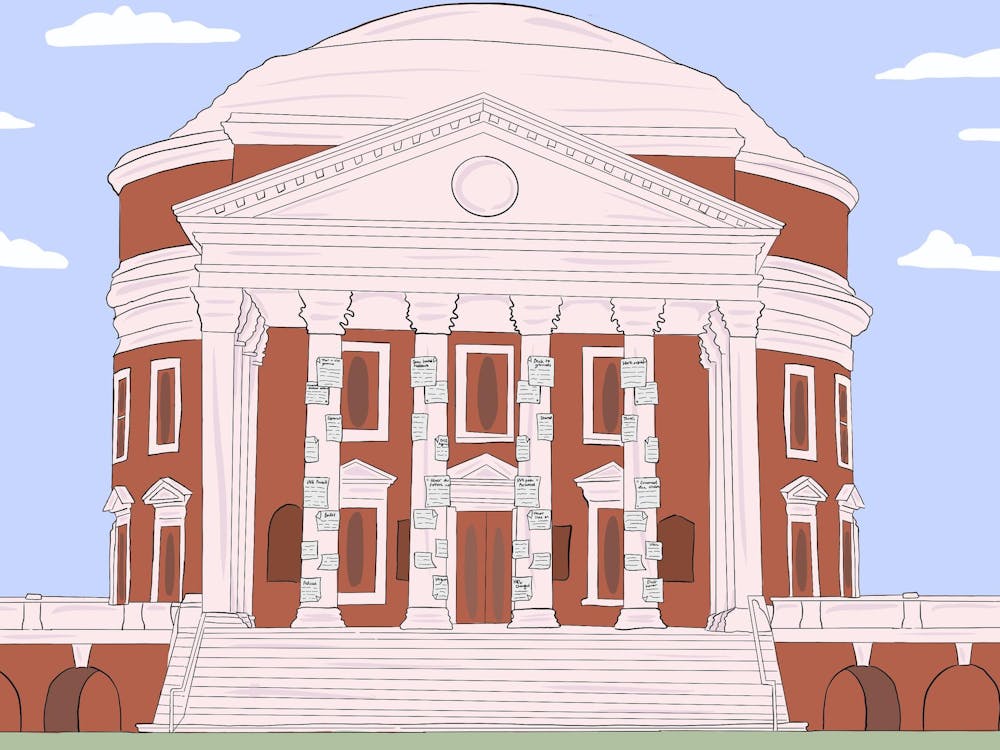I guess I shouldn't have been surprised. Schools from the University of Hawaii to Columbia University have seen controversy flair up over cartoons deemed racist over the last few years. This was such a common theme that when I was managing editor of NYU's student paper, the editor and I knew specifically to look out for this sort of problem.
Still, I was hoping this wouldn't happen here, not to editors I liked working with and thought worked very hard. But that's exactly what happened after The Cavalier Daily ran Daniel Gantz's strip, Self-Proclaimed, on Oct. 23.
The cartoon depicted the honor code at the University starting with Thomas Jefferson kicking a slave off his plantation for stealing tobacco. It ran on a Tuesday and by Sunday, editor-in-chief Patrick Harvey had received an influx of e-mail complaints about the cartoon.
People shared how they had read the cartoon, regardless of their belief of the artist's intent. "The cartoon, to me, says that the need for the honor code is because we have black students on grounds," one reader said. The cartoon seemed to say that honor code existed "due to the dishonesty of black people."
Many noted that the honor code has been mired in controversy, with minorities and women prosecuted at a greater rate than white males. The cartoonist ignored that while attempting to comment on the code.
Some called the decision irresponsible, arrogant and insensitive, expressed a "lack of confidence" in the editor and accused the paper of wanting to "stir up controversy and increase readership."
Harvey issued an e-mail, trying to explain the cartoon and his decision to run it, but not apologizing.
"I knew this comic would be controversial," Harvey said. "However, I felt it was appropriate to run the comic because it presented slavery as it existed. To not allow any portrayal of slavery hides the true horror of the institution." He then argued that slavery's horrors were minimized after the Civil War, contributing to the "subordination of black Americans." We need to understand history to "deal with racial demons today."
Unfortunately, that e-mail only exacerbated the problem. Understandably, many of the black students on Grounds felt insulted that the editor had basically tried to give them a history lesson about slavery. On top of that, readers rightly pointed out that the cartoon did not, in fact, depict slavery as it existed. "Sorry Pat, but slaves were not kicked off the plantation," wrote grad student Trevor Brown. "They were raped, mutilated and executed."
That struck me, too, when I first read it. What slave wouldn't be excited by being thrown off a plantation? It's not like being freed would have been a punishment.
At a university with a reputation for tense race relations, this year has already seen its share of problems. Students have told of being taunted with racial epithets, and others reported racist graffiti on personal white boards. Some aren't convinced the FBI was right when it declared graffiti painted over two black student organizations' announcements on Beta Bridge was not racist. In that light, the cartoon was especially inflammatory.
"You picked the wrong time, wrong place, wrong medium and wrong school to begin your goal of portraying the realities of slavery," one reader, Ifunanya Agbim wrote. "At this point here at UVA, any little tiny minute detail that has anything in the world to do with race or stereotyping or prejudice will automatically be extremely emotional to minorities on grounds."
Gantz wrote a letter to readers, explaining that he was trying to criticize Thomas Jefferson "for his hypocritical view of supporting scientific racism while being known for authoring the words 'all men are created equal.'"
The cartoon was mediocre, at best. When I first read the cartoon, I was more confused than anything. I didn't understand the artist's point, and I wasn't even certain the revolutionary-era figure was supposed to be Thomas Jefferson. Even though cartoons often use caricatures of people, most include identifying markers to make sure the message is clear.
When the message is muddled, intent is muddled. While I do not believe Gantz meant to pin the honor code's existence on slaves, nor do I think he wanted to say that blacks are untrustworthy, the cartoon can be read that way.
Truth is usually the best defense against libel. Similarly, accuracy can be what parties have to fall back on in instances like this. That is where Gantz and Harvey made a critical error. The cartoon is not deeply rooted in history. As both acknowledge, Jefferson did not institute the honor code, which wasn't implemented until 1842.
One raison d'etre of editors is to help writers clearly get their message across. It's easier to edit an opinion column than a cartoon, for obvious reasons, but the guidance must still be there. It's not always easy to see when your work misses the mark. I'd say that Gantz's editors failed him, and themselves.
Lisa Fleisher can be reached at ombuds@cavalierdaily.com.






